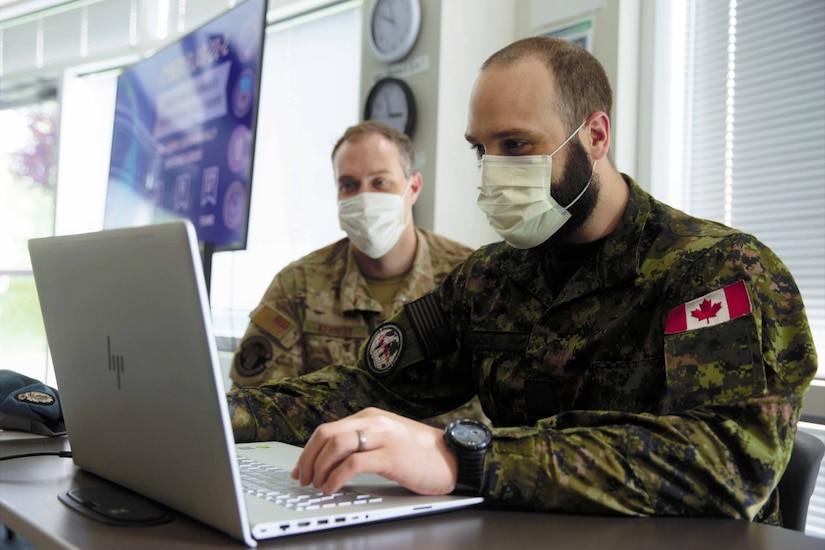Dec. 4, 2020 |
As part of the Defense Department's efforts to sharpen lethality, reform business practices and strengthen partnerships in cyberspace, the U.S. and Australia have launched the first agreement to continuously develop a virtual cyber training range.
Both nations signed the Cyber Training Capabilities Project Arrangement on Nov. 3. The bilateral, international agreement enables U.S. Cyber Command to incorporate Australian Defense Force feedback into Cybercom's simulated training domain, the Persistent Cyber Training Environment.

The PCTE is a cyber training platform for real-world defensive missions across boundaries and networks. Its shared use and development will constantly evolve it and sharpen readiness in cyber tactics, techniques and procedures.
"This project arrangement is a milestone for U.S.-Australian cooperation. It is the first cyber-only arrangement established between the U.S. Army and an allied nation, which highlights the value of Australia's partnership in the simulated training domain," Elizabeth Wilson, the U.S. signatory and deputy assistant secretary of the Army for defense exports and cooperation, said.
"To counter known and potential adversarial threats, the Army has recalibrated our strategic thinking; we've made smart decisions to refocus our efforts to invest in the new, emerging and smart technologies that will strengthen our ability to fight and win our nation's wars," she added.
Previously, U.S. and allied cyber forces developed cyber training ranges for specific scenarios that would be used once, a process that could take months. The PCTE offers a collaborative training environment, enabling cyber forces around the world to develop and reuse already existing content to train at individual and group levels anytime.
"Australia and the U.S. have a strong history of working together to develop our cyber capabilities and train our people to fight and win in cyberspace," Australian Army Maj. Gen. Marcus Thompson, the Australian signatory and head of information warfare for the ADF, said. "This arrangement will be an important part of the ADF's training program, and we look forward to the mutual benefits it will bring."
Partnerships in cyberspace are key to generating and sharing insights of threat actors, enabling mutual defense against cyberattacks and conducting the operational training necessary to hold adversaries accountable in cyberspace. Such training platforms enable lethal cyber mission forces in defense of U.S. and allied interests.
"Agreements like this one are crucial to the efficiency of our joint modernization," Wilson said. "They lay the framework for our mutual growth, allowing us to become stronger and more interoperable as allies."

The Army has the lead in developing PCTE and worked with the program executive office for simulation, training and instrumentation on this cooperative cyber project with Australia. The PEO STRI is responsible to deliver and improve PCTE on behalf of the Joint Services. Currently, PCTE's primary user is Cybercom and the services' cyber components.
"PCTE continues to showcase training opportunities for our cyber equities, and, as we evolve this capability, we look forward to the ongoing progression and engagements with our partners," Navy Rear Adm. Christopher Bartz, director of exercises and training for Cybercom, said. "Our recent Cyber Flag events in June and September of 2020 were prime examples of Five Eyes partner training and collaboration."
PCTE is one component of the U.S. military's Joint Cyber Warfighting Architecture, an overarching framework that helps guide capability development across all services for a functional, adaptive system of systems.
About PCTE
The PCTE training platform delivered its first production version in February 2020 and is designed as a distributed, secure, reconfigurable environment where numerous independent cyber operations training activities may occur simultaneously.
These environments include virtual emulations of live networks that allow cyber operators the ability to practice their skills and operations in a closed environment.
A key aspect of PCTE, which provides the earliest access to capabilities, is the incorporation of an iterative development process. This process allows for the continued development and improvement of PCTE while it is in use by cyber warriors.

Cyber mission forces first identified the need for a shared, iterative virtual cyber range during exercise Cyber Flag 2015 and have since galvanized an expedited effort to define the requirement and find technical solutions. Leveraging agile acquisition and rapid prototyping, cyber mission operators actively test and provide feedback during development, enabling PCTE to meet their operational needs.
The long-term goal for PCTE is to provide the DOD cyberspace workforce the capability to build and conduct full-spectrum, combined and joint cyberspace training, exercises, certification and mission rehearsal in a training environment. The training environment requirements, driven by training objectives and user-defined specifications, must emulate a realistic operational environment that provides scope, scalability and fidelity.
The CTC PA is an example of how the cyber mission forces of the U.S. and Australia work together and showcases success in the Armaments Cooperation. The project arrangement, valued at $215.19 million over six years, provides the flexibility to develop cyber training capabilities for the future.







No comments:
Post a Comment